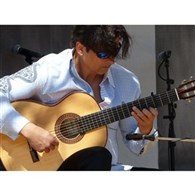Welcome to one of the most active flamenco sites on the Internet. Guests can read most posts but if you want to participate click here to register.
This site is dedicated to the memory of Paco de Lucía, Ron Mitchell, Guy Williams, Linda Elvira, Philip John Lee, Craig Eros, Ben Woods, David Serva and Tom Blackshear who went ahead of us.
We receive 12,200 visitors a month from 200 countries and 1.7 million page impressions a year. To advertise on this site please contact us.
|

|
|
transposing falsetas to different palos
|
You are logged in as Guest
|
|
Users viewing this topic: none
|
|
Login  | |
|

   
Gabewolf
Posts: 67
Joined: Feb. 12 2016
From: Cleveland, Ohio

|
 transposing falsetas to different palos transposing falsetas to different palos
|
|
|
Hey guys, in a post entitled "what palo is this song?" someone was asking about some Lorca that was set to bulerias. Ricardo responded with this really interesting explanation:
quote:
Compas and palos are two different things....sort of like a 12 bar blues verses a bluesy song or one that swings that might not be a proper blues structure. One could say fandango has a compas in 3/4, like in huelva styles, however a singer can sing a fandango Copla to compas of solea, buleria, tango, rumba, tanguillo etc etc. Think of compas as a "treatment" of a melody not as part of the melody itself. That's why they use the adjective "por buleria" or "por bla ba" to describe the treatment of a song melody. And not just singing.... a guitar solo might be described the same way....for example "Rondeña" for guitar players is a special tuning and key, so "Rondeña por buleria" the falsetas will be set to compas of buleria.
And then I saw a really cool video of Moraito doing this type of thing in a master class. I was wondering if there was a limit to this, can you put solea falsetas into bulerias por arriba? Would you just need to add a pick up note on beat 12? What are the rules for this? What about something like alegrias that has a different scale? Can you just alter some of the notes? Sorry if this is a dumb/loaded question, I am fascinated by this concept and it makes me want to dig even deeper into flamenco than I already have!
|
|
|
|
REPORT THIS POST AS INAPPROPRIATE |
Date Oct. 17 2017 23:43:19
 |
|

  
Piwin
Posts: 3559
Joined: Feb. 9 2016

|
 RE: transposing falsetas to differen... (in reply to Gabewolf) RE: transposing falsetas to differen... (in reply to Gabewolf)
|
|
|
There is no limit but at a certain point you'd have to move away from the idea of transposing (which is technically just shifting music to a lower or higher pitch) and think almost in terms of composition.
One way of thinking about composing is to view it as just re-arranging pre-existing components. That bit you heard from that musician you liked, that beat you learned from a friend. How about that melody in C major you like but arrange it with the "minor" element? etc. etc. "Transposing" falsetas from one palo to another is just a very simplified version of this.
But it's flamenco, so you're not just trying to freely create something new, you're operating under certain constraints. You want it to sound like that palo. And to make it sound like that palo, there's no easy answer really.
This might be a flawed analogy but anyways, for what it's worth:
Imagine you have a newspaper clipping and you want to transpose it into a poetic form (more or less the compas). That's the "easy" part. At least, it's easy to know what the rules are. Say you want to turn it into a sonnet. You know the rhyme scheme, you know to use iambic pentameter for starters and you know you need a volta if you want it to be any good. So then you take the newspaper clipping, and you use all the tools you have in your linguistic toolkit to make it fit into the structure of a sonnet. You paraphrase, sum up, find synonyms, etc. etc.
Now imagine you want to transpose your newspaper clipping into a poetic genre (more or less the palo). Now that's the hard part. How do you turn a newspaper clipping into epic poetry? into an elegy or a fable? Here the rules are less clear and you have to rely much more on intuition. If you want to turn it into an elegy, you have to start by figuring out what defines an elegy. If you want to write an elegy in the form of a sonnet, getting the sonnet part down is easy. It's getting the elegy part down that is really difficult.
And so when "transposing" a falseta. Switch a falseta from a 4 beat tangos to a 12 beat alegrias. OK, I'll work on the rythm to make the phrasing fit with the strong beats in alegrias. I'll switch modes, etc. I'll look for synonyms for certain parts, etc. But then you've only transposed into the form, not into the genre. What you've got may fit into the alegrias compas, but it sure doesn't feel like alegrias. So how do you transform it into the genre? You start out by asking yourself what characteristics define the genre you're aiming for. What defines an alegrias? What are the tropes, what are the common techniques, and more importantly what is the underlying feeling it is meant to convey? And then you use every single tool in your musical toolkit to switch it over to that. Chances are the end result will sound very little like the falseta you started out with.
PS: this exercise is also very dependent on what you're trying to transform and how close/distant it is to what you want to make of it. Switching from seguiriya to alegrias is probably overall harder than say tangos to bulerias. For the same reason that it's easier to write that elegy in the form of a sonnet if your news clipping reads "mother of 4 dies in car crash" than if it reads "Brad and Jennifer's lavish wedding". In some cases, the original content might be so distant from the target that it may not even be worth even trying to transform it, other than a sheer technical exercice. There is no limit per se, just aesthetics.
_____________________________
"Anything you do can be fixed. What you cannot fix is the perfection of a blank page. What you cannot fix is that pristine, unsullied whiteness of a screen or a page with nothing on it—because there’s nothing there to fix."
|
|
|
|
REPORT THIS POST AS INAPPROPRIATE |
Date Oct. 18 2017 6:16:55
 |
|
 New Messages New Messages |
 No New Messages No New Messages |
 Hot Topic w/ New Messages Hot Topic w/ New Messages |
 Hot Topic w/o New Messages Hot Topic w/o New Messages |
 Locked w/ New Messages Locked w/ New Messages |
 Locked w/o New Messages Locked w/o New Messages |
|
 Post New Thread
Post New Thread
 Reply to Message
Reply to Message
 Post New Poll
Post New Poll
 Submit Vote
Submit Vote
 Delete My Own Post
Delete My Own Post
 Delete My Own Thread
Delete My Own Thread
 Rate Posts
Rate Posts
|
|
|
Forum Software powered by ASP Playground Advanced Edition 2.0.5
Copyright © 2000 - 2003 ASPPlayground.NET |
0.0625 secs.
|


 Printable Version
Printable Version









 )
)  New Messages
New Messages No New Messages
No New Messages Hot Topic w/ New Messages
Hot Topic w/ New Messages Hot Topic w/o New Messages
Hot Topic w/o New Messages Locked w/ New Messages
Locked w/ New Messages Locked w/o New Messages
Locked w/o New Messages Post New Thread
Post New Thread